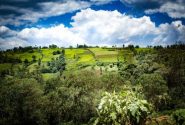BOGOR, Indonesia (22 January, 2013)_The high amount of carbon that pours into the atmosphere when arid and semi-arid land is converted for Jatropha oil production may outweigh the environmental benefits of such a biofuel, says a new report.
The findings run contrary to popular beliefs.
As the world struggles to find ways to reduce greenhouse gas emissions to mitigate climate change many countries are embracing “clean-burning” biofuels as the renewable energy of choice.
Biofuel crops planted in semi-arid landscapes are considered more attractive than those found in plush, humid regions because they can be produced sustainably, pose little threat to potential food production and are better for ecosystem conservation.
But Wouter Achten, a scientist with The University of Leuven in Belgium and lead author of Global greenhouse gas implications of land conversion to biofuel crop cultivation in arid and semi-arid lands – lessons learned from Jatropha says they may not be the solution many had hoped for.
Jatropha has been promoted as one of the best arid-land biofuel crops, in part because of the high yields of oil extracted from its seeds. It also has strong resistance to drought and pests.
But cultivating it in a way that is beneficial to the environment is difficult, says Achten.
In some areas the yields are likely not enough to justify the emissions caused during the further processing and transport of the fuel.
Jatropha yields, for example, would need to range from 9 to 14 tonnes of seeds per hectare per year on arid and semi-arid land for 30 years to repay the carbon debt created by converting dry forest. Only after this period would a net emission reduction be achieved by using the fuel produced, Achten said.
“In some areas the yields are likely not enough to justify the emissions caused during the further processing and transport of the fuel.”
The carbon stocks in arid lands are low – ranging from 2 to 136 tonnes per hectare (compared to around 260 tonnes of carbon per hectare in Indonesia’s tropical rainforests).
“However, we also need to consider the amount of carbon released from clearing and soil tillage when these lands are converted to crops,” Achten said.
For some land types, such as cultivated and managed cropland, the carbon debt may not be too significant. But conversion of these types of land to other uses may trigger indirect impacts (such as food crops being relocated to other lands), often causing additional carbon emissions elsewhere.
As such, biofuel crops selected for their ability to help slow climate change should not be grown in places where the initial loss of carbon is so large that it will take many years of growing biofuel crops and building carbon stocks to counteract such a loss, Achten argued.
“I do not want to say that biofuel production or development should be stopped in these lands,” he said, stressing that his study focused on a single crop.

Unripe jatropha fruit drying prior to oil extraction. Wouter Achten
“But when aiming at greenhouse gas reduction, the potential of these lands might be limited.”
One also cannot ignore the socio-economic impacts, which “might further restrict the area available and suitable for sustainable biofuel production.”
“These and other activities will have impacts on water, biodiversity and soil structure,” Achten said.
There still might be middle ground, he said.
The challenge is finding it.
“I think a balance can be reached by using areas with low carbon stocks, for example, abandoned cropland, and that have no risk for indirect land-use change,” he said.
“However, the lands which meet these ‘requirements’ are likely scarce.”
This work is part of CIFOR’s Global Comparative Study on REDD+, which is supported by The Norwegian Agency for Development Cooperation (NORAD) and AusAid.
We want you to share Forests News content, which is licensed under Creative Commons Attribution-NonCommercial-ShareAlike 4.0 International (CC BY-NC-SA 4.0). This means you are free to redistribute our material for non-commercial purposes. All we ask is that you give Forests News appropriate credit and link to the original Forests News content, indicate if changes were made, and distribute your contributions under the same Creative Commons license. You must notify Forests News if you repost, reprint or reuse our materials by contacting forestsnews@cifor-icraf.org.












